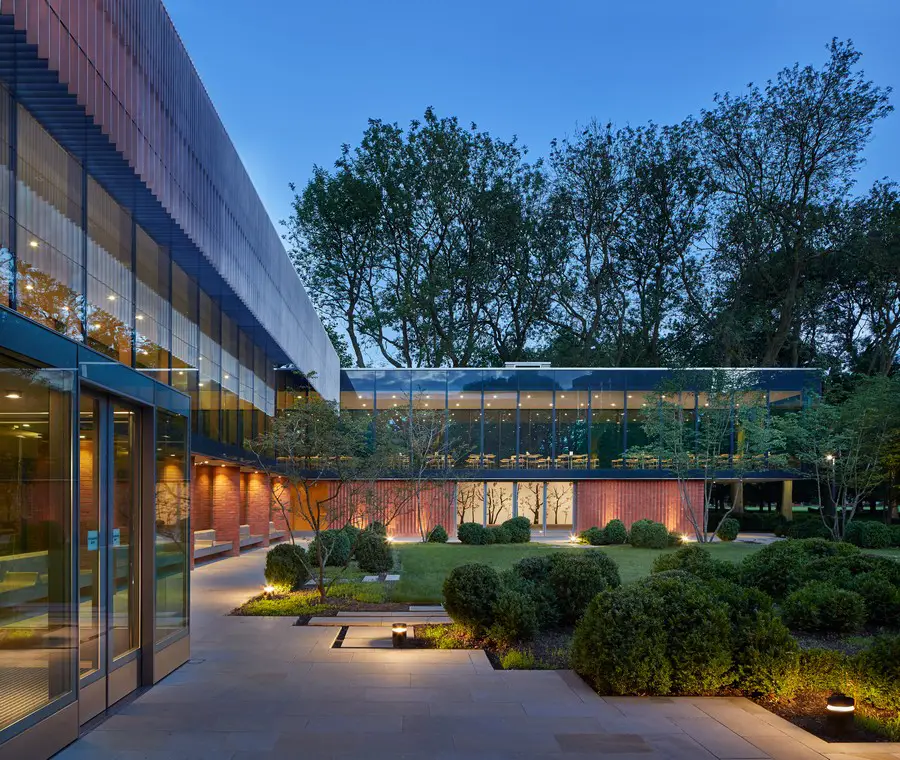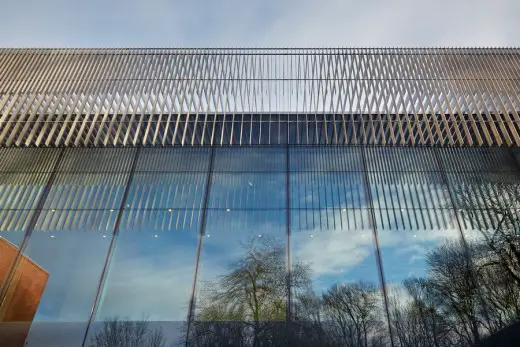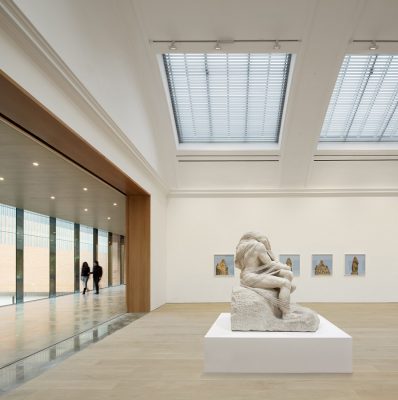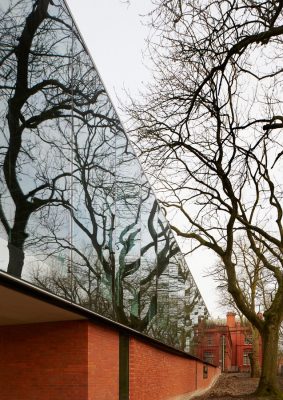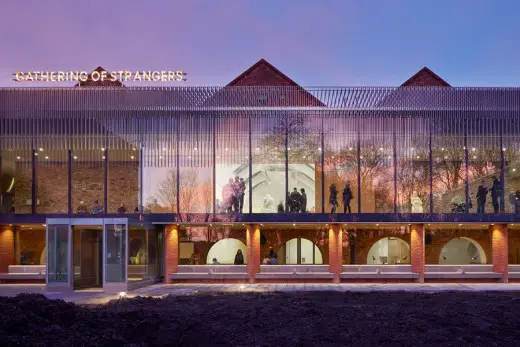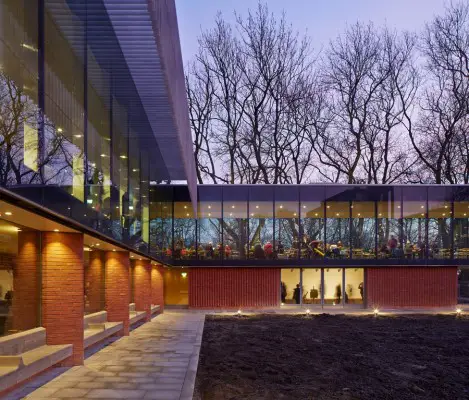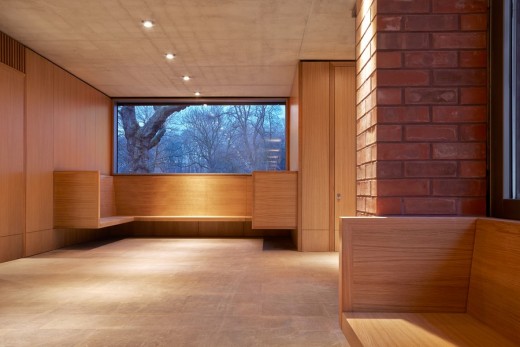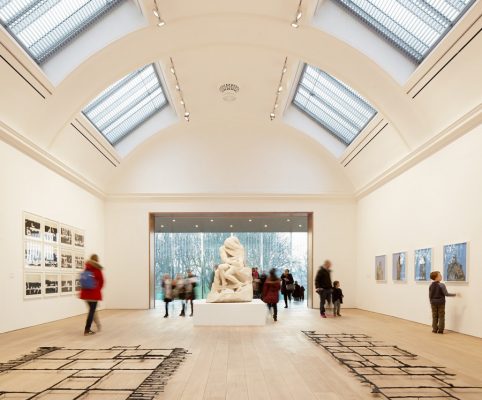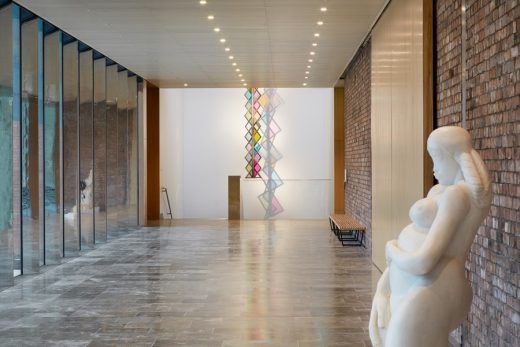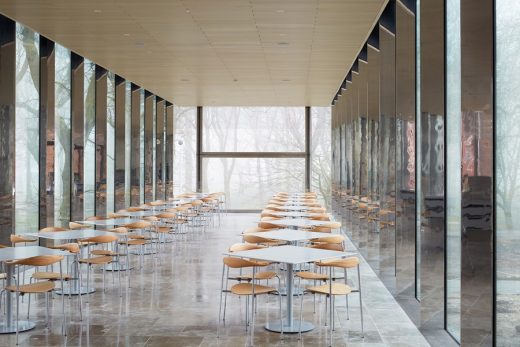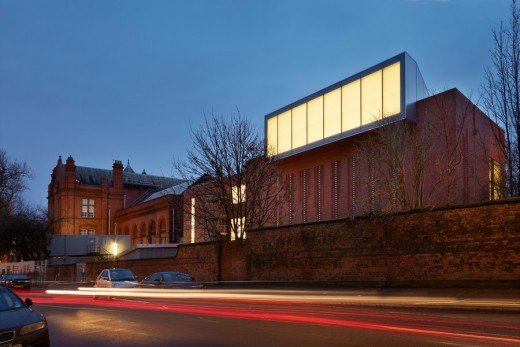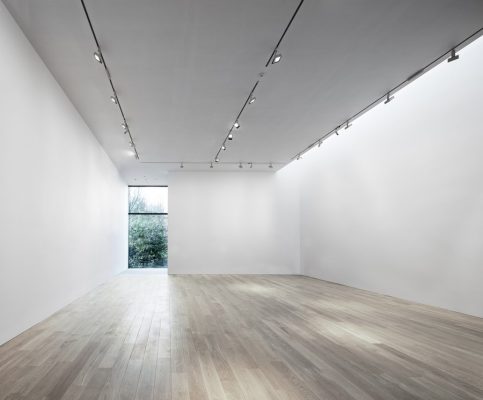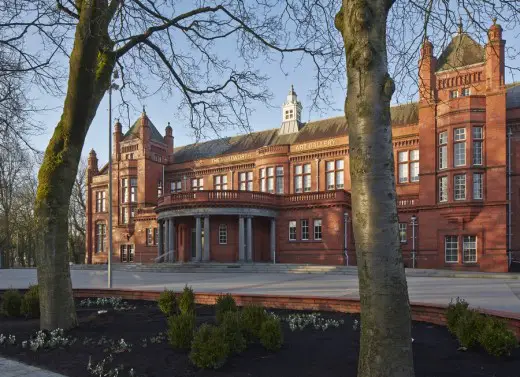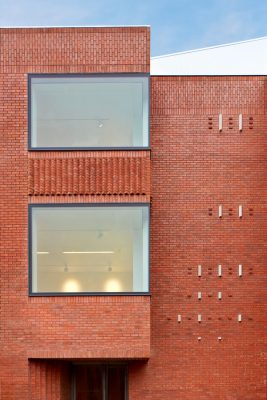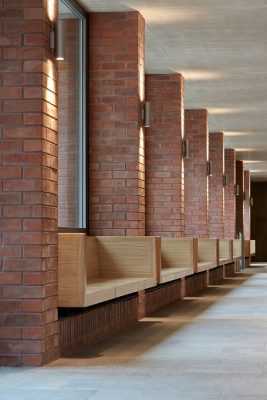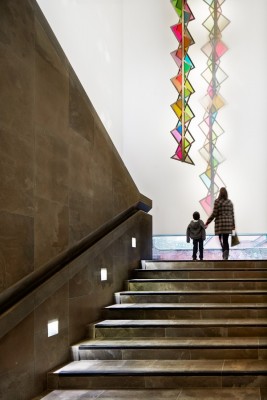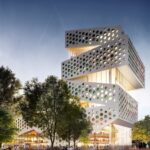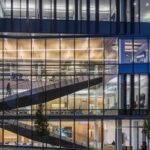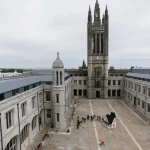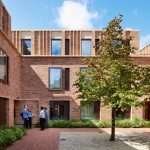The Whitworth Gallery Extension, Oxford Road Manchester Building, England, Project, Images
The Whitworth Gallery Extension
University of Manchester Building Extension in England, UK – design by MUMA
2 Jan 2017
The Whitworth Gallery Extension Shortlisted for Mies van der Rohe 2017 Awards
Mies van der Rohe 2017 Award Nominations
page updated 30 Oct 2016 with new photos ; 5 May 2015
The Whitworth Gallery Extension in Manchester
Design: MUMA, architects
Location: The University of Manchester, Oxford Road, Manchester, Lancashire M15 6ER, UK
Manchester arts and cultural centre to open soon
MUMA (McInnes Usher McKnight Architects) were selected in November 2009 through an architectural competition run by the Royal Institute of British Architects (RIBA), held following the Whitworth’s award of a Stage 1 pass from the Heritage Lottery Fund in February 2009. An initial field of 139 competition entrants was narrowed from a long list of 10 to a short list of 5 architectural firms that each submitted designs. These were subject to public scrutiny through an exhibition in the Gallery and an on-line presence, as well as being considered in depth by a judging panel chaired by the Chancellor of the University of Manchester, Tom Bloxham MBE. The completed design remains true to that submitted under the competition and is a response to the Client’s aspirations and clear and considered requirements, the site, and the inherent potential of the existing gallery.
The Whitworth
With a growing national and international profile, an expanding audience (increasing from 86,000 in 2006 to 139,000 in 2008), an ambitious exhibitions and educational programme and an expanding collection (the collections number over 55,000 objects, all stored on site) the gallery found a need to expand.
The client’s competition brief expressed an aim to make the internationally important collection of fine art, textiles and wallpaper, accessible to a wider range of visitors, to make better use of the existing gallery spaces and to establish a relationship with the surrounding grounds and park. The brief included the following quote:
“I have come to the conclusion that a good museum or gallery should be a place where people feel comfortable. If it stands in a garden or park, the visitors should be able to enjoy the beauty of the outdoors as a counterpoint to what is within.” Margaret Pilkington, Whitworth Art Gallery Director, following a visit to Oslo, 1932
This quote struck a chord with us and underpins our design approach at the Whitworth. New visual connections to the park are created and celebrated. Equally important to us was the opportunity to establish a new transparency – the intention being to break down the perceived psychological barriers* created by both the formal late Victorian/Edwardian entrance and the blind, unarticulated rear of the existing building – this new transparency inviting further exploration.
* According to the client’s detailed consultation, undertaken as part of the preparations for the project, many locals commented that they found the formal entrance intimidating, with many being uncertain that they were even ‘allowed to enter’.
The Building and it’s Site
The Whitworth is a public art gallery founded in 1889, as the first English gallery in a park. It became part of the University of Manchester in 1958. The Gallery is situated in the north east corner of Whitworth Park on the edge of the University campus in the Moss Side Ward, close to the local communities of Moss Side and Rusholme. The gallery fronts Oxford Road, opposite Manchester Royal Infirmary, and to the North is skirted by Denmark Road – a mixed use street, including some residential units.
The Whitworth Art Gallery is an amalgamation of a number of separate stages of development that have been undertaken over the past 126 years. Beaumont, the original architect, undertook 5 projects over an 18 year period to transform a private residence, Grove House, into a public art gallery. The final project that he oversaw was the completion of the main frontage building in 1908. During the 1960’s, John Bickerdike and Partners substantially remodelled the interior of the building creating modern, contemporary gallery spaces within the Beaumont building. In 1995 ABK (Ahrends, Burton and Koralek) created a Sculpture Court at Mezzanine level within the centre of the plan.
The combination of late Victorian/Edwardian envelope and 1960’s modern interior was Grade II listed in 1974, with the Bickerdike interior being of particular note.
Externally, the 1908 frontage facing Oxford Road to the east and earlier elements to the north and south elevations, were well resolved. However, the west end of the building facing the park, was of lesser quality and presented an unresolved, blind mass to the park. As a consequence, this area felt neglected and often suffered from graffiti.
The Design
Our design responds to the existing characteristics of the site and building. The new extension encapsulates the unresolved west end, creating a new frontage to the park. The architectural hierarchy and scale has been considered carefully to ensure that the clarity of the principal entrance off Oxford Road is not undermined.
Two new wings of contrasting character extend into the park containing a garden court (the Art Garden) and new entrance – a setting for art and events which can bring new life to this part of the park. To the south, the transparent, slender wing of the cafe and its south facing terrace celebrate the park context and the avenue of mature trees. To the north the more solid form of the Landscape Gallery and Study Centre provide an urban edge and a visual and acoustic buffer that contains the garden. The north wing also houses new and much needed back-of-house facilities including a new loading bay, art handling facilities and a substantial goods lift that can deliver art to the three main levels of the existing building. (Prior to this there was no mechanical way to deliver substantial art to, for example, the existing sculpture gallery at mezzanine level).
New openings have been created in the existing building at significant locations connecting the new extension and providing the heart of the building with a range of long views – each connecting with green space beyond.
A promenade gallery wraps the existing exhibition galleries and provides a vantage point to view the garden and park beyond. This glazed link maximises the visual connections to and from the park, and connects the central exhibition gallery to the garden. Thus, artworks inside can connect with artworks outside. The promenade also provides an environmental buffer, critical to the passive approach to environmental control, additional display space most suited for sculpture and a more informal environment within which visitors can relax.
In plan the promenade is repeated at lower ground floor – a space of a very different character, which turns the former windowless basement into a generous lower ground floor. This lower promenade engages with the Art Garden and creates a welcoming informal park entrance at the west of the Whitworth. The Art Garden is lined with education facilities – a Collection Centre, Study Centre and a Learning Studio, from which classes can spill out into the Art Garden.
The creation of this courtyard and promenade allows light and park views into the heart of the existing building and turns an area of the park into a defensible space – one that is owned and overlooked by the gallery – the opposite of the previous situation. It offers an outdoor venue for events including, in the evenings, digital projection onto the wall of the Landscape Gallery. On rainy days, such events can equally be enjoyed from the glazed promenade and café over-looking the Art Garden. We envisage this to be, on occasion, a vibrant, changing environment, a place for artistic experimentation and enjoyment. In the hands of the Whitworth we have no doubt that this is a space where wonderful, odd things can and will happen.
Located as a destination on the main gallery level promenade, the Landscape Gallery to the north can provide a calm environment for the enjoyment of art. For a gallery often displaying landscape drawings and paintings, to us natural light and a visual connection with the park were fundamental. The gallery is rooflit and has a view addressing a single tree and the park beyond. To allow for flexibility there are light control mechanisms to both the rooflight and the window. The scale of the gallery and its structure will allow for contemporary works of considerable scale and weight.
Also placed at main gallery level, off the promenade, the café occupies the new south wing. In this location, each visit to the Whitworth’s café will draw the visitor through the building leading to an encounter with art within the gallery. With its transparent linear form positioned above a sloping site, as the ground falls away, diners will find themselves within the tree canopy – a dining experience unique to Whitworth Art Gallery. The end of the café cantilevers creating a covered external space for the Learning Studio below.
Materials
The solid elements of the north wing and lower ground floor are formed out of red brickwork (a bespoke ‘Whitworth Blend’ developed with brick manufacturer Northcot) – this is often articulated, sometimes with handmade faience elements. The brick bond patterns draw inspiration from the Whitworth’s textile collection. The brick articulation at entrances and particular openings creates shelter or casts shade – the depth of the reveals emphasising the mass of these elements. By way of counterpoint, the structure of the transparent café and promenade has been reduced to a series of slender polished stainless steel mullions – triangular in plan, they reflect the trees beyond, such that structure dissolves, visually, amongst the leafy reflections.
The glazed west elevation is protected from solar gain by the depth of the brickwork at lower ground level, incorporating sculpted Purbeck stone seating facing the garden and oak seating in the lower promenade. A delicate stainless steel brise soleil veil shades the ground level promenade. Designed to cast shade whilst also maintaining views, the fine stainless steel fins are engineered such that they may flex in the wind.
Internally the materials are influenced by the Bickerdike interior – self finished materials; brick, Purbeck stone, timber (oak and ash) and terrazzo. Exposed concrete (with a high GGBS content) and lime plaster, provide thermal mass and a hygroscopic buffer in the collection zones.
Layering and patterning is considered throughout – from the rhythm of structural and architectural elements such as the promenade mullions and brise soleil, to the detail of the striated glass frit and slatted timber screens – as are the qualities of light and the interplay of shadow, reflection and transparency. Together these are intended to enrich and enliven the building whilst the restrained material palette serves to retain a sense of calm that is appropriate as a background to the building’s function.
The Existing Building
Over time the Whitworth had been altered and reconfigured, often resulting in inappropriate, compromised and inefficient use of spaces. The new extension has acted as a kind of pressure release valve, allowing rationalisation and improved efficiency.
For example, the original Grand Hall on the first floor of the Whitworth had been altered in the 1970s to contain collection storage and provide study and office space. Suspended ceilings, concealing air conditioning and partitions had been added. Although not originally required by the brief, we proposed in our competition submission excavating an underused area of the basement (to create usable headroom) and relocating the collection store next to a new collection access zone (the Collection Centre) off the new lower promenade.
Our strategy was to work with the inherent characteristics of the building – the high daylit volume of the Grand Hall has now been recovered as a place of gathering – for lectures, workshops or functions. By relocating the collection, within the inherently stable environment of the basement, with passive means we have created a stable environment for the collection. With no external walls (being wrapped by the new promenade) and benefitting from the substantial thermal mass of the historic fabric, temperature is stable. Humidity fluctuations are tempered by the use of lime plaster, with breathable paint to all walls and ceilings. Employing such means, together with a conservation heating strategy, has meant that we were able to remove air conditioning.
The relocation of the collection from the first floor to the basement, in conjunction with creating the lower promenade answered the client’s original desire to make the collection more accessible. The collection stores are now adjacent to a Collection Centre (itself an environmental buffer) and this space together with the adjacent Study Centre are now made visible to the general public upon entering from the Art Garden, encouraging further engagement.
Minimising environmental impact was a clear aspect of the brief and the project has responded to this in the logical distribution and use of spaces, (both in the existing building and the new extension), the specification of sustainable materials and a passive approach to environmental servicing. By these means the target carbon consumption reduction of 10% will be achieved for the whole building (against the emissions of the existing building), despite the building size having increased by one third. The assessment carried out by the BREEAM consultant to date has confirmed that the ‘building is on track to be awarded BREEAM ‘Excellent’
With the realisation of this project, the Whitworth Art Gallery no longer has a rear, rather it embraces the park with new accessible facilities around a new courtyard garden and a new park entrance. Whilst the building has been expanded by one third, the publicly accessible space has almost doubled.
The New Sculpture Terrace & Entrance
Prior to this project the main entrance off Oxford road was often very congested. All deliveries were received here, the café was squeezed in to the entrance hall and at the same time school groups were received here. An unsightly dog-legged metal ramp had been added in the 1990s to provide a step free route over the stepped podium at the main entrance. In reconfiguring the building the pressure on this entrance has been eased, a new loading area and staff entrance have been created, whilst schools will now enter via the park entrance and the café is relocated, allowing the gallery to expand its shop.
Externally the levels have been resolved with a raised sculpture terrace and a new more gracious stone podium providing step free access. The sculpture terrace establishes a new public space of considerable scale at the front of the Whitworth, its formality responding to and reinforcing the importance of the original entrance, whilst installations and events taking place on the terrace, will engage passers-by.
Photographs: Alan Williams Photography
The Whitworth Gallery Extension in Manchester image / information from MUMA
Address: The Whitworth Art Gallery, Oxford Rd, Manchester M15 6ER, UK
Phone: 0161 275 7450
Manchester, Northwest England, UK
Manchester Buildings
Contemporary Manchester Architecture
Manchester Architecture Walking Tours
Manchester Architecture Offices
Manchester Architecture Photos
Manchester Architecture Photos : Key New Buildings
Great Marlborough St Tower
Design: Hodder + Partners
Great Marlborough Street Tower
Gary Neville’s House, Bolton
Design: Make, Architects
Gary Neville House
The Point, Old Trafford Cricket Ground
Design: BDP, Architects
Old Trafford Cricket Ground
Website: The Whitworth
Manchester Law Courts
DCM, Architects
Manchester Civil Justice Centre
Beetham Tower – Tallest residential tower in Europe
Ian Simpson Architects
Manchester Hilton
Website: MUMA
Examples of Manchester Architecture welcome: info(at)e-architect.com
Manchester Buildings Photographs
Comments / photos for the The Whitworth Gallery Extension in Manchester page welcome
Manchester – Arts venue

